I hope this overview will induce you to follow up on the details of our Great Lakes adventure.
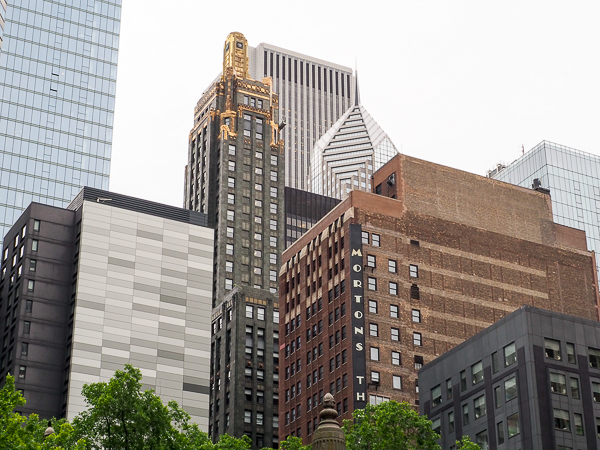
The first day featured an Architectural Boat Tour in Chicago. The gold-leaf tower in the center was built in 1929 for the Union Carbide and Carbon Company. It is now a hotel.
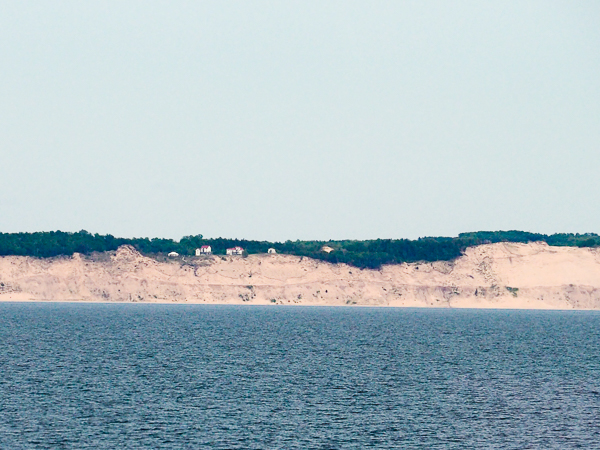
The following day was spent at sea (at lake?). We cruised the eastern shore of Lake Michigan on our way to Mackinac Island. It features huge sand dunes. Sleeping Bear Dunes National Lakeshore protects many miles of dunes on the mainland and adjacent islands. This picture shows a cluster of houses to provide scale. I don't know if this is part of the protected area or not.
Sand mining is a major extraction business in Michigan and in some areas the dunes have been leveled. There have been various past and ongoing attempts to protect the dunes through regulation. Of course any such attempts will be controversial with opposing commercial and environmental interests. Past history suggests that short-term commercial thinking costs more in the long run, but ....
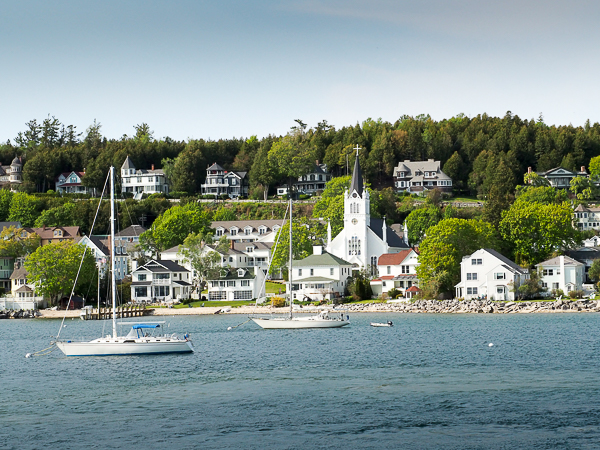
Mackinac Island has been a popular tourism site since the 19th century. Prior to that time it was a center for the fur trade with the Native Americans. J. J. Astor made his fortune here.
Our visit was on a Sunday so I attended the service at the local Congregational Church (not the church in the picture). It was nice to meet folks. One gentleman was a 5th generation Mackinac Islander, although he now lives on the mainland in the winter.
This was the beginning of our time-zone tango. Over the course of the cruise we bounced back and forth between Eastern Daylight Time (EDT) (home), Central Daylight Time (CDT) (Chicago), EDT (Mackinac Island & the Upper Peninsula), CDT (Duluth), EDT (Thunder Bay & Sault Ste. Marie), CDT (Green Bay), EDT (Muskegon), CDT (Chicago), and finally back to EDT at home. That's eight clock changes in 14 days! We were never quite sure what time it was.
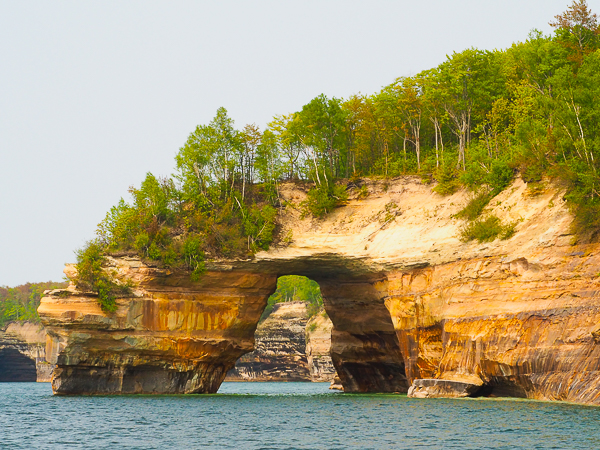
The day after our stop at Mackinac Island was originally planned to be another day at sea, but the cruise folks arranged a visit to the Pictured Rocks National Lakeshore outside Munising, Michigan. We transferred from our ship to a smaller excursion boat.
The colorful rocks are the result of differing minerals in the layers forming the bluffs.
Violent Lake Superior storms have sculpted the rock into arches, free-standing stacks, and caves. The lake near the cliff is treacherous. This stretch is infamous as the shipwreck coast. Some storm pictures can be seen at the link as well as a video describing some of the wrecks that can still be seen on the beach or underwater. Scuba diving on the wrecks is a popular pastime with special guides and outfitters, such as Shipwreck Explorers, and others.
We were glad to be visiting in summer, not autumn.
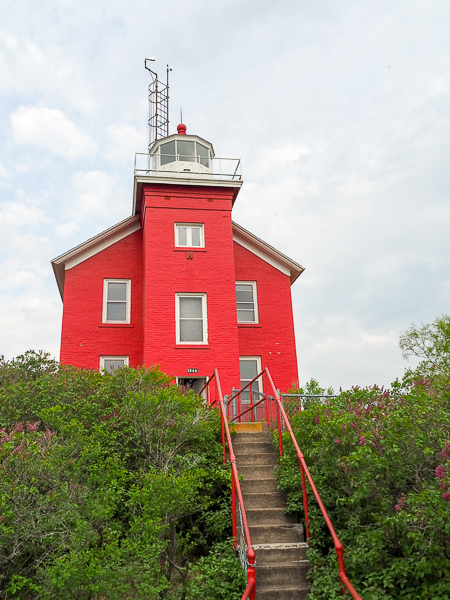
At one time the lighthouse keeper of the Marquette Harbor Light lived with his (or her) family in the lighthouse building. The local historical society is in the process of restoring the keeper's residence. The light is now automated.
At one time there was a Coast Guard rescue station at the harbor and also an installation of fog signals that has since been removed.
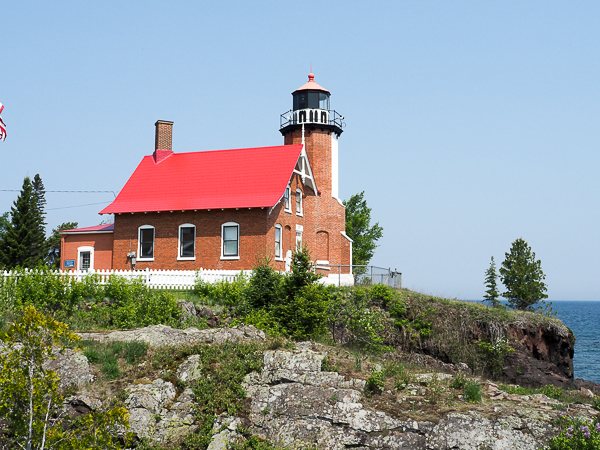
My favorite excursion of the trip was an all-day exploration of the Keweenaw Peninsula. It was a beautiful place and at least a couple of us would have considered moving there, were we thirty years younger. There is the small detail of the average 200" plus annual snowfall.
Native American mined ancient copper formations as far back as 5000 years ago. Keweenaw copper is exceptionally pure and prior to European contact was traded as far as Florida and perhaps even to the Aztec empire.
The Eagle Harbor Light is on the northern shore of the peninsula. There was extensive interior and exterior renovation underway so we were not able to go inside.
One of the local residents complained about the light shining inland where it wasn't needed, so the Coast Guard agreed to put a blackout curtain on the landward side of the light.
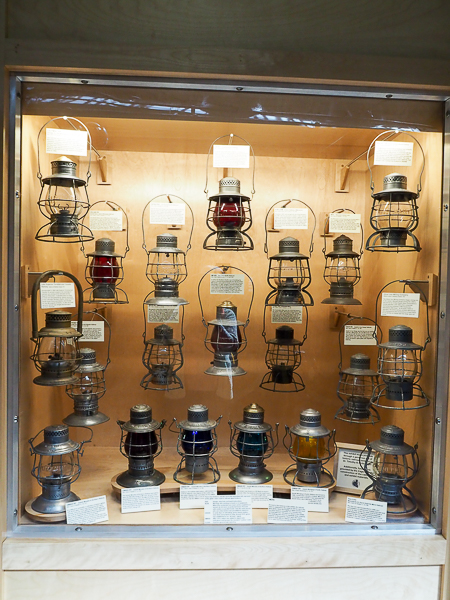
There was an all-day excursion in Duluth as well, but it was rated as "intense" and I wasn't sure my knee was up for it. Jim and I opted for the Lake Superior Railroad Museum and Scenic Railroad. It was deadly dull even though we love everything about trains.
There was this neat display of antique lanterns from a variety of rail lines including the row on the bottom with an explanation of what the various colors of lanterns signified.
Jim once had similar lanterns that had belonged to his grandfather.
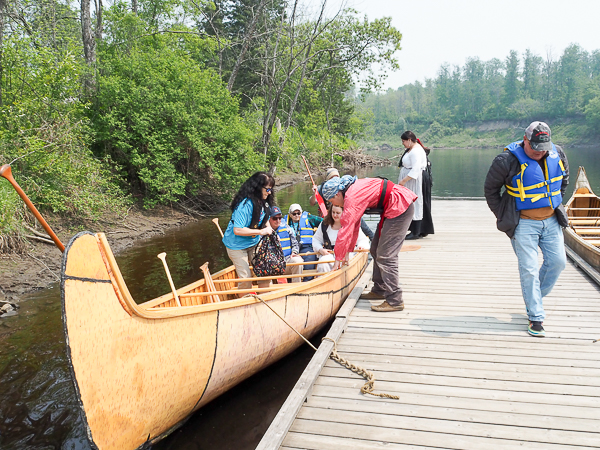
In Thunder Bay, Ontario, I opted for a visit to the restored Ft. William fur trading post outside of town. The excursion featured a short trip in a birchbark canoe similar to those used by the French-Canadian voyageurs during the early 19th century. This canoe was much larger than the ones I paddled when getting my Girl Scout canoeing badge!
The voyageurs used even larger vessels called Montreal Canoes to haul tons of trade goods to the west to trade for tons of furs to take back to Montreal. We fit about ten paddlers into this one (yes, we had to paddle), but there would have been no room for cargo. It was harder work than I remembered, and I am no longer as graceful getting into and out of a canoe as I once was.
Elsewhere at the fort we were able to see the process of making birchbark canoes.
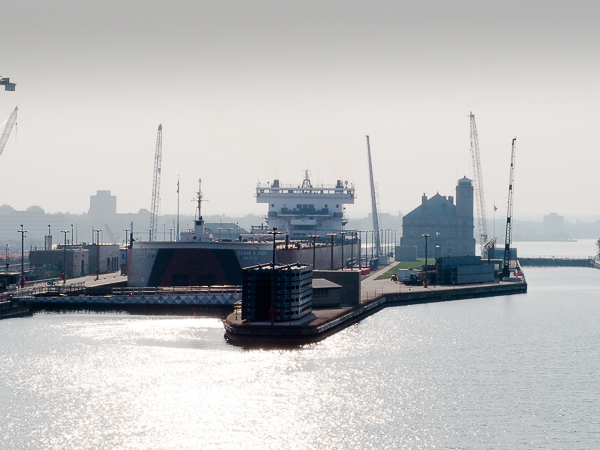
After two nights & a day cruising the length of Lake Superior (it's a BIG lake), we arrived at the Soo Locks. On the up-bound trip, we had locked through at night. I woke up to watch, but couldn't see much. For our down-bound leg, we passed the locks early in the morning.
The Poe and MacArthur locks are on the American side. There is also an smaller lock on the Canadian side used mostly for pleasure craft. The Poe lock can accommodate large lakers, but there is a need for an additional large lock, which is currently under construction. Continuing funds to complete the work are in jeopardy under the Trump administration, so its status is uncertain.
Our ship will be locking down in the smaller MacArthur lock on the right. At the same time, the 1000-footer Edgar B. Speer is locking up in the adjacent Poe lock.
After passing the lock, we will dock and enjoy various excursions in the area.
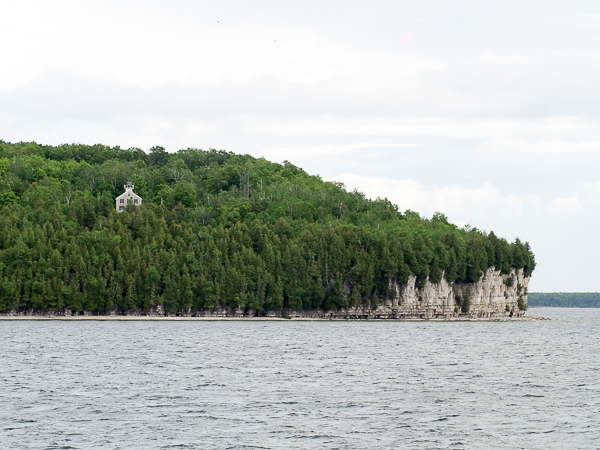
It took us another two nights and a day to travel from Sault Ste. Marie to Green Bay, Wisconsin. I was surprised at the number of islands we passed on the way, especially as we entered the body of water known as Green Bay.
This is aptly named Rock Island and the lighthouse is the Potawatomi Light.

Green Bay is a delightful city and the locals turned out in force to welcome us. The dock was in the middle of downtown and several folks walked out to visit local restaurants.
One of our buses is in the background of this picture. Victoria Cruise Lines uses three buses that followed us around from port to port, except for Thunder Bay which required the use of a local bus company. It was nice to have consistent quality every day, and we got to know the bus drivers as well. Those buses put on the miles!
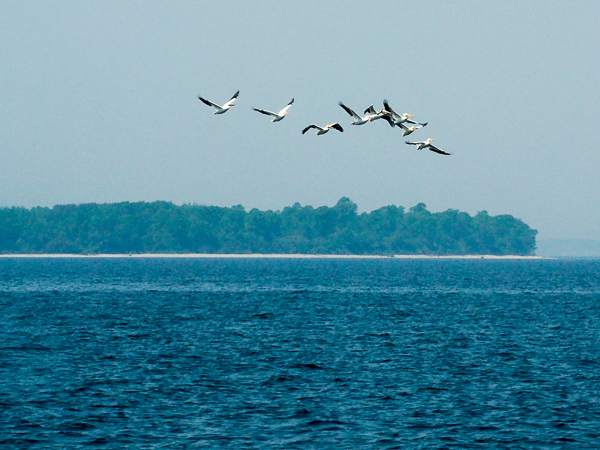
The ship spent the night in Green Bay and left in the morning for our next stop in Muskegon, Michigan. Again we passed numerous islands until we reached the open water of Lake Michigan.
We were told that pelicans had mostly disappeared from this area due to the fish having been killed by pollution. They have returned in great numbers as the lakes have partially recovered. There are still many ecological challenges due to continuing industrial pollution, agricultural runoff, and introduced invasive species such as zebra mussels, alewife, and sea lampreys.
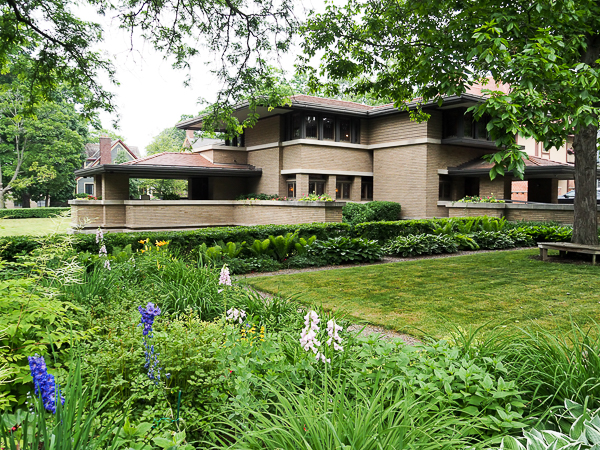
Muskegon is an interesting town in its own right, but I had signed up for an excursion to Grand Rapids to visit two Frank Lloyd Wright houses and a botanical garden.
The Meyer May house was built in 1908-09 for the owner of a local clothing store. Steelcase purchased the house in 1985 and restored it to its 1910 condition by removing an addition and repairing structural problems that had accrued over the years. They were able to obtain many original pieces of furniture and reproduce many others based on archival pictures and specifications.
The nearby David M. Amberg house, owned by Mr. May's in-laws was also available for visiting.
After touring the houses, we enjoyed the Meijer Gardens and Sculpture Park.
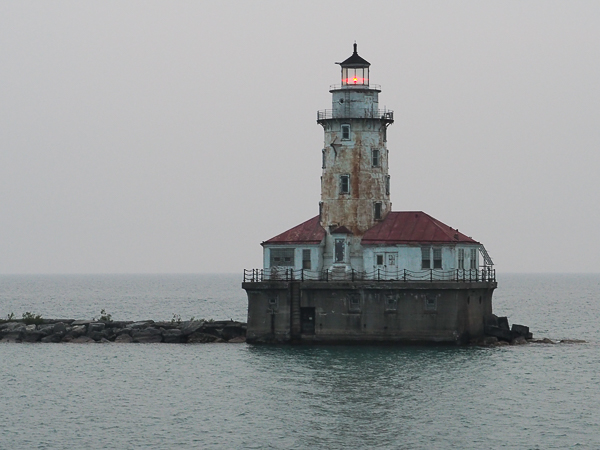
After leaving Muskegon, our ship headed down and across the lake to arrive in Chicago at dawn. I woke up early to see us come in. The Chicago Harbor Light is due for restoration. It needs it!
It was a wonderful trip with mostly calm waters. The temperatures ranged from chilly to warm, but we escaped rain except for the first night out of Chicago and a brief drizzle in Thunder Bay. Unfortunately the forest fire smoke stalked us throughout the trip.
I hope you will visit the detailed pages for many more pictures and much more information that I found fascinating. I hope you do too.
Click your "back" button to return to the previous page or click for our picture album.